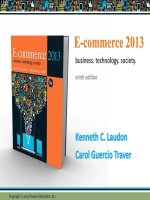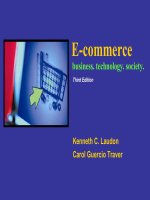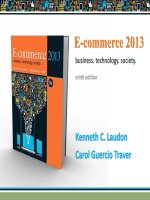Lecture E-commerce: Business, technology, society (3/e): Chapter 14 - Kenneth C. Laudon, Carol Guercio Traver
Bạn đang xem bản rút gọn của tài liệu. Xem và tải ngay bản đầy đủ của tài liệu tại đây (1.17 MB, 50 trang )
E-commerce
business. technology. society.
Third Edition
Kenneth C. Laudon
Carol Guercio Traver
Copyright © 2007 Pearson Education, Inc.
Slide 14-1
Chapter 14
Online Content Providers: Digital
Media
Copyright © 2007 Pearson Education, Inc.
Slide 14-2
The Wall Street Journal Online
Class Discussion
Why did the Wall Street Journal succeed with a
subscription model when other newspapers have
been unable to charge for their content?
Would you pay to read a daily newspaper online?
Why or why not?
Would you pay for access to online archives of
newspapers and/or magazines?
Do you think newspapers can make the transition
from “print on paper” to “news on screen?”
Copyright © 2007 Pearson Education, Inc.
Slide 14-3
Trends in Online Content—2006
Increased media consumption
Internet media revenues fastest growing
Internet advertising revenues rapidly expanding,
driving interest in content that attracts eyeballs
Paid content becoming more commonplace
Convergence increasing
User-generated content explodes in popularity
More and more entertainment content finds its way
onto the Web
Copyright © 2007 Pearson Education, Inc.
Slide 14-4
Content Audience and Market
Average American adult spends over 3,900
hours each year consuming various media
By 2008, expected to increase to 4, 000
hours a year (about 11 hours a day)
Most popular medium: television, followed by
radio
Internet third, but growing fast
Copyright © 2007 Pearson Education, Inc.
Slide 14-5
Media Utilization
Figure 14.1, Page 815
SOURCE: Based on data from U.S. Census Bureau , 2006.
Copyright © 2007 Pearson Education, Inc.
Slide 14-6
Internet and Traditional Media:
Cannibalization versus Complementarity
Time spend on Internet reduces consumer time
available for other media
Internet users view television only 11.2 hours per
week, compared to 16 hours per week for non-users
Internet users spend 15% to 20% less time reading
books, newspapers and magazine, and less time on
phone or listening to radio
Conversely, Internet users consume more media of
all types than non-Internet users
Internet users also often multitask, using other forms
of media at same time as using Internet
Copyright © 2007 Pearson Education, Inc.
Slide 14-7
Media Revenues by Channel
Figure 14.2, Page 816
SOURCE: Based on data from U.S. Census Bureau, 2006.
Copyright © 2007 Pearson Education, Inc.
Slide 14-8
Growth of the Online Content Audience
Online content: digital information for direct
consumption made available over the Internet
Includes both free and paid content
Differences between consumer content (B2C)
and business content (B2B) markets
2006: Total direct consumer paid online
content revenues in U.S. should reach about
$5.8 billion
Expected to grow to $12.9 billion by 2012
Copyright © 2007 Pearson Education, Inc.
Slide 14-9
Fee or Free?
Major challenge facing online content industry
Most content on Web is still free, and most
Web users still expect it to be free
Movement toward paying for content will
require significant enhancement to content
providers’ customer value propositions
Copyright © 2007 Pearson Education, Inc.
Slide 14-10
Media Industry Structure
Media content industry prior to 1990 was composed
of many smaller independent corporations
specializing in content creation and distribution in
separate industries
Still organized largely as separate vertical
stovepipes, with each segment dominated by a few
key players
Growing use of digital creation tools and growth of
Internet as delivery vehicle offer promise of
convergence toward a more unified creation and
distribution platform
Copyright © 2007 Pearson Education, Inc.
Slide 14-11
Media Convergence: Technology,
Content, and Industry Structure
Three dimensions of media convergence:
Technological convergence: Development of hybrid
devices that can combine the functionality of two or more
existing media platforms into a single device
Example: PDAs that can also be used as cell phones
and book readers
Content convergence has three aspects
Convergence in design
Convergence in production
Convergence in distribution of content
Industry convergence: Merger of media enterprises into
synergistic combinations that create and cross-market
content on different platforms
Best known example: AOL/Time Warner
Copyright © 2007 Pearson Education, Inc.
Slide 14-12
Convergence and the Transformation
of Content: Books
Figure 14.3, Page 821
Copyright © 2007 Pearson Education, Inc.
Slide 14-13
Challenges and Risks in Media
Convergence
Consumers still prefer traditional media
Technology is not quite ready to distribute
content effectively and conveniently
Content creators (artists, writers, producers)
do not yet know what features consumers are
willing to pay for and are still creating content
for each of the separate media types
Profitable business model has not yet
emerged
Copyright © 2007 Pearson Education, Inc.
Slide 14-14
Online Content Revenue Models and
Business Processes
Basic content revenue models
Marketing
Advertising
Pay-per-view/Pay-for-download
Subscription
Mixed
Copyright © 2007 Pearson Education, Inc.
Slide 14-15
Making a Profit with Online Content:
From Free to Fee
Many content firms have decided that there is more
to be gained by offering either all free content or a
mix of free and for-free
Four factors required to charge for online content
Focused market
Specialized content
Sole source monopoly
High perceived net value (portion of perceived
customer value that can be attributed to fact that
content is available on the Internet)
Copyright © 2007 Pearson Education, Inc.
Slide 14-16
Revenue and Content Characteristics
Figure 14.4, Page 826
Copyright © 2007 Pearson Education, Inc.
Slide 14-17
Key Challenges Facing Content Producers
and Owners
Technology challenges
Bandwidth issues
Client platform
Cost challenges
Internet distribution more costly than anticipated;
media companies face substantial costs in migrating,
repackaging, and redesigning content for online
delivery
Consumer attitudes
Cannibalization of existing distribution channels
Digital rights management challenges
Theft of copyrighted material
Royalties paid to artists and writers
Copyright © 2007 Pearson Education, Inc.
Slide 14-18
Insight on Business: DRM: Who Owns
Your Files
Class Discussion
Why does digital content need any more
protection than analog content stored on records
and tapes?
What is DRM software? Have you ever
encountered digital content that is protected with
DRM?
How does Apple’s iPod and iTunes use DRM?
In what way did DRM make iTunes possible?
How does DRM potentially interfere with “fair
use” of copyrighted material?
Copyright © 2007 Pearson Education, Inc.
Slide 14-19
Online Newspapers
More than 5,000 online newspapers worldwide
About 1,300 online newspapers in the United States
Online newspapers one of most successful forms on
online content to date
Impact of Internet on content
Enables premium archived content
Enables fine-grained search
Extends reach
Extends depth of content
Copyright © 2007 Pearson Education, Inc.
Slide 14-20
Monthly Unique Visitors at Major Online
Newspapers
Figure 14.5, Page 832
SOURCE: Based on data from Newspaper Association of America, 2006b; comScore
Networks, 2005; eMarketer, Inc., 2005c.
Copyright © 2007 Pearson Education, Inc.
Slide 14-21
Online Newspaper Revenue Models and
Results
Predominately rely on advertising model, with
varying success
Supplement revenues by using a pay-perview/pay-for-download model for premium or
archival content and/or subscription fees
Only a few newspapers with strong offline
brands such as Wall Street Journal have
been able to successfully use subscription
model
Copyright © 2007 Pearson Education, Inc.
Slide 14-22
Convergence in the Online Newspaper
Industry
Technological convergence in infancy with
only published text moved to Web
Content convergence has occurred in areas
of production and distribution
Industry structure has not seen much
movement to cross-media convergence
Copyright © 2007 Pearson Education, Inc.
Slide 14-23
Online Newspapers: Challenges
Developing wireless mobile delivery platforms and
micropayment systems to provide low-cost
mechanism for selling single articles
Consumer attitudes have remained intransigent on
issue of paying for content
Some online newspapers have experienced
cannibalization of main distribution channel
Digital leakage, where paid for and downloaded
content is redistributed via e-mail or posted for few
viewing on a Web site
Copyright © 2007 Pearson Education, Inc.
Slide 14-24
E-books
Many different types of commercial e-books
Web-accessed e-book
Web-downloadable e-book
Dedicated e-book reader
Print-on-demand books
Copyright © 2007 Pearson Education, Inc.
Slide 14-25









